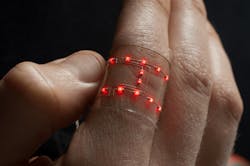Hybrid 3D printing creates flexible wearable devices containing rigid optoelectronics
Flexible skin-worn electronic and optoelectronic devices that aim to track and measure the body's movements need to bend and stretch, yet integrating rigid electrical components on or within skin-mimicking matrix materials has proven to be challenging. Such components cannot stretch and dissipate forces like soft materials can, and this mismatch in flexibility concentrates stress at the junction between the hard and soft elements, frequently causing wearable devices to fail.
Now, a collaboration between the lab of Jennifer Lewis at the Wyss Institute for Biologically Inspired Engineering at Harvard University (Cambridge, MA) and the Harvard John A. Paulson School of Engineering and Applied Sciences (SEAS) and J. Daniel Berrigan and Michael Durstock at the US Air Force Research Laboratory (AFRL; Wright Patterson Air Force Base, OH) has created a hybrid 3D printing technique for flexible electronics and optoelectronics that integrates soft, electrically conductive inks and matrix materials with rigid electronic components into a single, stretchable device.1
Choosing the approach
Generally, there are two approaches that can be taken to create a flexible, and ideally stretchable, skin-worn optoelectronic device: 1) making the actual electronics and optoelectronics flexible as well as the matrix, as has been done by Philips Research (Eindhoven, Netherlands), and 2) embedding rigid electronics and optoelectronic devices in a flexible matrix with flexible (and hopefully stretchable) conductors, as was done by groups led by Imec (Leuven, Belgium) and by the University of Illinois at Urbana-Champaign (Urbana, IL). This new Harvard/AFRL approach falls into the latter group.
"With this technique, we can print the electronic sensor directly onto the material, digitally pick-and-place electronic components, and print the conductive interconnects that complete the electronic circuitry required to read the sensor's data signal in one fell swoop," says Alex Valentine, who was a researcher at the Wyss Institute when the study was completed and is currently a medical student at the Boston University School of Medicine.
The stretchable conductive ink is made of thermoplastic polyurethane (TPU), a flexible plastic that is mixed with silver flakes. Both pure TPU and silver-TPU inks are printed to create the devices' underlying soft substrate and conductive electrodes, respectively. "Because both the substrate and the electrodes contain TPU, when they are co-printed layer by layer they strongly adhere to one another prior to drying," says Valentine. "After the solvent evaporates, both of the inks solidify, forming an integrated system that is both flexible and stretchable."
Because these surface-mounted electrical components (such as LEDs, resistors, and microchips) are hard and rigid, the team took advantage of TPU's adhesive properties by applying a dot of TPU ink beneath each component prior to attaching it to the underlying soft TPU substrate. Once dried, the TPU dots serve to anchor these rigid components and distribute stress throughout the entire matrix, allowing the fully assembled devices to be stretched up to 30% while still maintaining function. A device composed of 12 LEDs attached to a flat TPU sheet created using this method was able to be repeatedly bent into a cylindrical shape without reduction in the intensity of the LEDs' light or mechanical failure of the device.
Proof-of-concept bend sensor
As a simple proof of concept, the team created two soft electronic devices. First, a strain sensor was fabricated by printing TPU and silver-TPU-ink electrodes onto a textile base and applying a microcontroller chip and readout LEDs via the pick-and-place method, resulting in a wearable sleeve-like device that indicates how much the wearer's arm is bending through successive lighting-up of the LEDs. The second device, a pressure sensor in the shape of a person's left footprint, was created by printing alternating layers of conductive silver-TPU electrodes and insulating TPU to form electrical capacitors on a soft TPU substrate, whose deformation patterns are processed by a manual electrical readout system to make a visual "heat map" image of the foot when a person steps on the sensor.
Source: https://wyss.harvard.edu/low-cost-wearables-manufactured-by-hybrid-3d-printing/
REFERENCE:
1. Alexander D. Valentine et al., Advanced Materials (2017); doi: 10.1002/adma.201703817

John Wallace | Senior Technical Editor (1998-2022)
John Wallace was with Laser Focus World for nearly 25 years, retiring in late June 2022. He obtained a bachelor's degree in mechanical engineering and physics at Rutgers University and a master's in optical engineering at the University of Rochester. Before becoming an editor, John worked as an engineer at RCA, Exxon, Eastman Kodak, and GCA Corporation.
